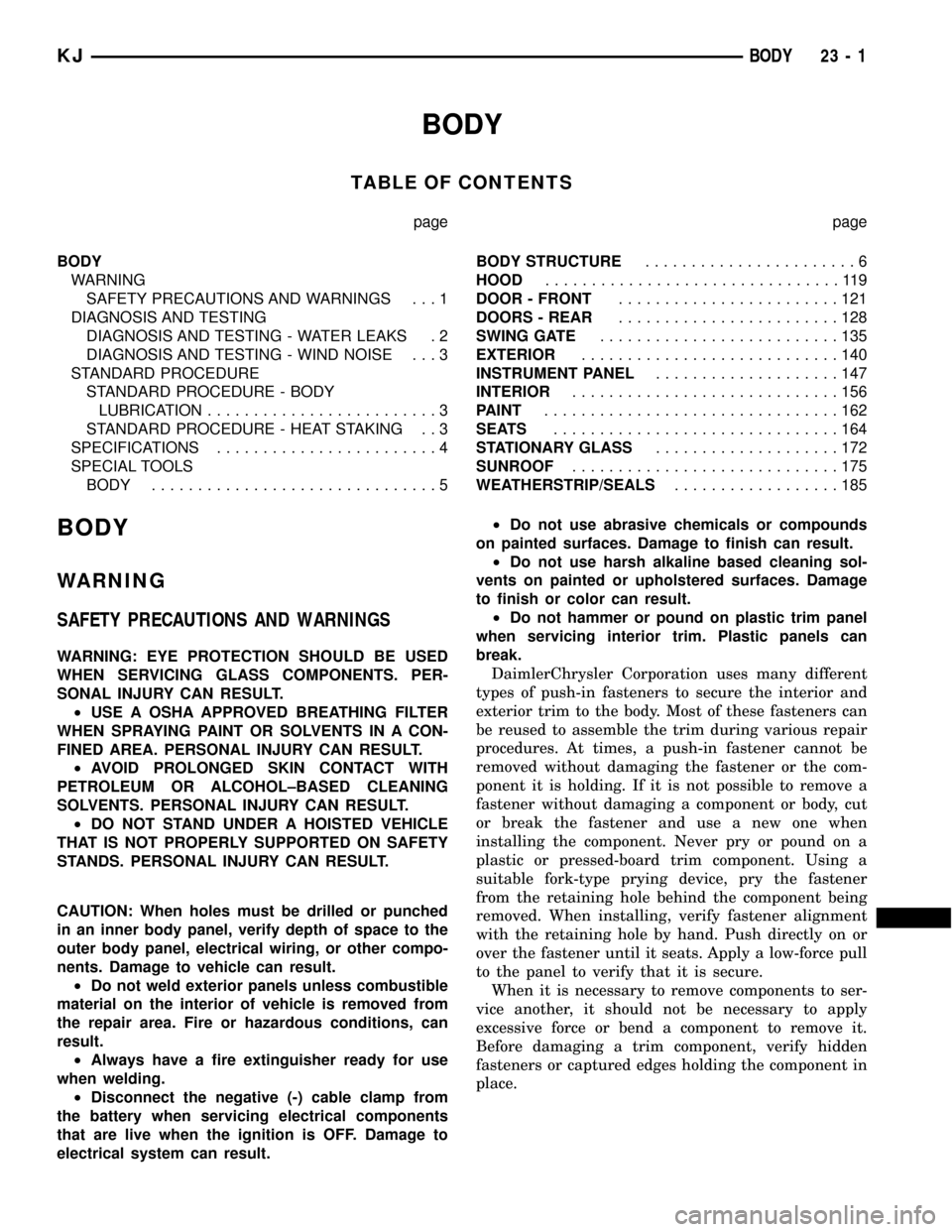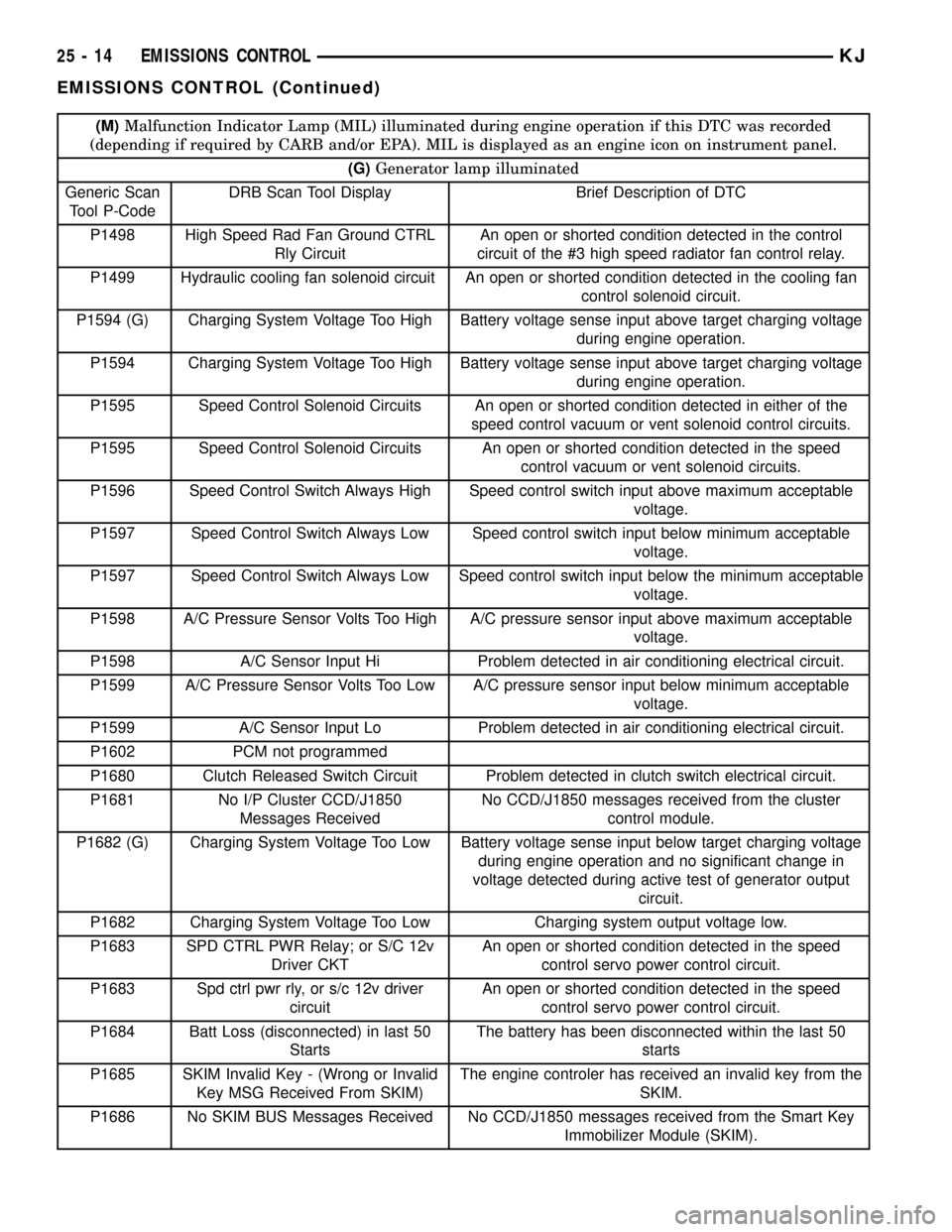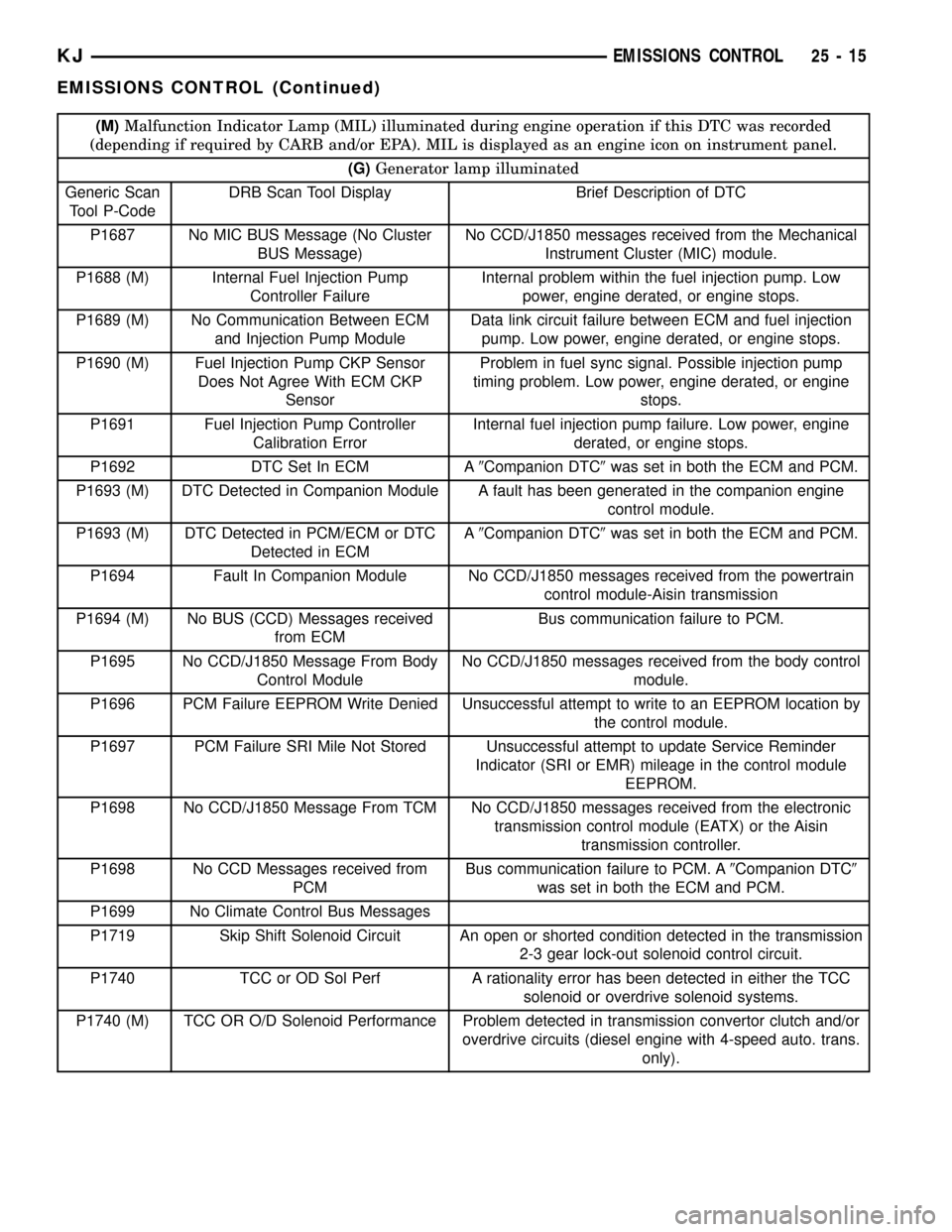2002 JEEP LIBERTY Bus
[x] Cancel search: BusPage 1466 of 1803

BODY
TABLE OF CONTENTS
page page
BODY
WARNING
SAFETY PRECAUTIONS AND WARNINGS . . . 1
DIAGNOSIS AND TESTING
DIAGNOSIS AND TESTING - WATER LEAKS . 2
DIAGNOSIS AND TESTING - WIND NOISE . . . 3
STANDARD PROCEDURE
STANDARD PROCEDURE - BODY
LUBRICATION.........................3
STANDARD PROCEDURE - HEAT STAKING . . 3
SPECIFICATIONS........................4
SPECIAL TOOLS
BODY...............................5BODY STRUCTURE.......................6
HOOD................................119
DOOR - FRONT........................121
DOORS - REAR........................128
SWING GATE..........................135
EXTERIOR............................140
INSTRUMENT PANEL....................147
INTERIOR.............................156
PAINT................................162
SEATS...............................164
STATIONARY GLASS....................172
SUNROOF.............................175
WEATHERSTRIP/SEALS..................185
BODY
WARNING
SAFETY PRECAUTIONS AND WARNINGS
WARNING: EYE PROTECTION SHOULD BE USED
WHEN SERVICING GLASS COMPONENTS. PER-
SONAL INJURY CAN RESULT.
²USE A OSHA APPROVED BREATHING FILTER
WHEN SPRAYING PAINT OR SOLVENTS IN A CON-
FINED AREA. PERSONAL INJURY CAN RESULT.
²AVOID PROLONGED SKIN CONTACT WITH
PETROLEUM OR ALCOHOL±BASED CLEANING
SOLVENTS. PERSONAL INJURY CAN RESULT.
²DO NOT STAND UNDER A HOISTED VEHICLE
THAT IS NOT PROPERLY SUPPORTED ON SAFETY
STANDS. PERSONAL INJURY CAN RESULT.
CAUTION: When holes must be drilled or punched
in an inner body panel, verify depth of space to the
outer body panel, electrical wiring, or other compo-
nents. Damage to vehicle can result.
²Do not weld exterior panels unless combustible
material on the interior of vehicle is removed from
the repair area. Fire or hazardous conditions, can
result.
²Always have a fire extinguisher ready for use
when welding.
²Disconnect the negative (-) cable clamp from
the battery when servicing electrical components
that are live when the ignition is OFF. Damage to
electrical system can result.²Do not use abrasive chemicals or compounds
on painted surfaces. Damage to finish can result.
²Do not use harsh alkaline based cleaning sol-
vents on painted or upholstered surfaces. Damage
to finish or color can result.
²Do not hammer or pound on plastic trim panel
when servicing interior trim. Plastic panels can
break.
DaimlerChrysler Corporation uses many different
types of push-in fasteners to secure the interior and
exterior trim to the body. Most of these fasteners can
be reused to assemble the trim during various repair
procedures. At times, a push-in fastener cannot be
removed without damaging the fastener or the com-
ponent it is holding. If it is not possible to remove a
fastener without damaging a component or body, cut
or break the fastener and use a new one when
installing the component. Never pry or pound on a
plastic or pressed-board trim component. Using a
suitable fork-type prying device, pry the fastener
from the retaining hole behind the component being
removed. When installing, verify fastener alignment
with the retaining hole by hand. Push directly on or
over the fastener until it seats. Apply a low-force pull
to the panel to verify that it is secure.
When it is necessary to remove components to ser-
vice another, it should not be necessary to apply
excessive force or bend a component to remove it.
Before damaging a trim component, verify hidden
fasteners or captured edges holding the component in
place.
KJBODY 23 - 1
Page 1643 of 1803

GLASS PANEL
REMOVAL
(1) Slide sunshade rearward to the open position.
(2) Move the glass panel to the closed position.
(3) Remove the four glass panel screws (Fig. 1).
(4) Lift off glass panel and remove from vehicle.
INSTALLATION
(1) Position glass panel on to mechanism lift arm.
(2) Start the four attaching screws.
(3) Center glass in opening by running a business
card around the glass.
(4) Adjust glass panel. (Refer to 23 - BODY/SUN-
ROOF/GLASS PANEL - ADJUSTMENTS)
ADJUSTMENTS
SUNROOF GLASS PANEL ADJUSTMENT
(1) Move the sunshade rearward to the open posi-
tion.
(2) Move the sunroof glass panel to the fully closed
position.
(3) Adjust the glass one corner at a time.
(a) Loosen four glass screws (Fig. 2).
(b) Lift glass assembly and align the top of the
glass panel to the top of the roof panel.
(c) Tighten screw to 3.5 N´m (31 in. lbs.).
(d) Repeat steps a. and b. for each corner of the
glass panel.
(e) When properly adjusted, the front of the
glass panel is 1.75 mm (0.07 in.) to 2.75 mm (0.11
in.) lower than the roof surface and the rear edgeof the glass panel is 1.75mm (0.07 in.) to .75 mm
(0.03 in.) lower than the roof surface.
NOTE: Glass assembly seal is 2.5mm (0.1 in) higher
than the glass panel. Measure at 300mm (11.8 in)
outboard of the centerline of the vehicle.
(4) Verify sunroof operation and alignment. Check
fit and re-adjust as necessary.
GLASS PANEL SEAL
REMOVAL
(1) Remove sunroof glass panel. (Refer to 23 -
BODY/SUNROOF/GLASS PANEL - REMOVAL)
(2) Place glass panel on clean work area with the
top side up. Support the glass assembly from under-
side to avoid bending or otherwise damaging the
mounting tabs.
(3) Grasp the seal and pull seal away from the
glass panel. The seal is a one piece seal.
INSTALLATION
NOTE: Always position seal seam on center of the
passenger side of glass panel.
(1) Place seal into position.
(2) Install seal on glass. Using care working the
seal around the glass, being careful not to over
stretch the seal while installing.
(3) Install the glass panel. (Refer to 23 - BODY/
SUNROOF/GLASS PANEL - INSTALLATION)
Fig. 1 GLASS PANEL
1 - SCREWS
2 - GLASS PANEL
3 - MODULE ASSEMBLYFig. 2 GLASS PANEL
1 - SCREWS
2 - GLASS PANEL
3 - MODULE ASSEMBLY
23 - 178 SUNROOFKJ
Page 1691 of 1803

In addition, the flexible hose refrigerant lines should
be routed so they are at least 80 millimeters (3
inches) from an exhaust manifold.
WARNING
SERVICE WARNINGS
WARNING: THE AIR CONDITIONING SYSTEM CON-
TAINS REFRIGERANT UNDER HIGH PRESSURE.
SEVERE PERSONAL INJURY MAY RESULT FROM
IMPROPER SERVICE PROCEDURES. REPAIRS
SHOULD ONLY BE PERFORMED BY QUALIFIED SER-
VICE PERSONNEL.
AVOID BREATHING THE REFRIGERANT AND REFRIG-
ERANT OIL VAPOR OR MIST. EXPOSURE MAY IRRI-
TATE THE EYES, NOSE, AND/OR THROAT. WEAR EYE
PROTECTION WHEN SERVICING THE AIR CONDITION-
ING REFRIGERANT SYSTEM. SERIOUS EYE INJURY
CAN RESULT FROM DIRECT CONTACT WITH THE
REFRIGERANT. IF EYE CONTACT OCCURS, SEEK
MEDICAL ATTENTION IMMEDIATELY.
DO NOT EXPOSE THE REFRIGERANT TO OPEN
FLAME. POISONOUS GAS IS CREATED WHEN
REFRIGERANT IS BURNED. AN ELECTRONIC LEAK
DETECTOR IS RECOMMENDED.
IF ACCIDENTAL SYSTEM DISCHARGE OCCURS, VEN-
TILATE THE WORK AREA BEFORE RESUMING SER-
VICE. LARGE AMOUNTS OF REFRIGERANT
RELEASED IN A CLOSED WORK AREA WILL DIS-
PLACE THE OXYGEN AND CAUSE SUFFOCATION.
THE EVAPORATION RATE OF R-134a REFRIGERANT
AT AVERAGE TEMPERATURE AND ALTITUDE IS
EXTREMELY HIGH. AS A RESULT, ANYTHING THAT
COMES IN CONTACT WITH THE REFRIGERANT WILL
FREEZE. ALWAYS PROTECT THE SKIN OR DELICATE
OBJECTS FROM DIRECT CONTACT WITH THE
REFRIGERANT.
THE R-134a SERVICE EQUIPMENT OR THE VEHICLE
REFRIGERANT SYSTEM SHOULD NOT BE PRESSURE
TESTED OR LEAK TESTED WITH COMPRESSED AIR.
SOME MIXTURES OF AIR AND R-134a HAVE BEEN
SHOWN TO BE COMBUSTIBLE AT ELEVATED PRES-
SURES. THESE MIXTURES ARE POTENTIALLY DAN-
GEROUS, AND MAY RESULT IN FIRE OR EXPLOSION
CAUSING INJURY OR PROPERTY DAMAGE.
CAUTION
SERVICE CAUTIONS
CAUTION: Liquid refrigerant is corrosive to metal sur-
faces. Follow the operating instructions supplied with
the service equipment being used.Never add R-12 to a refrigerant system designed to
use R-134a. Damage to the system will result.
R-12 refrigerant oil must not be mixed with R-134a
refrigerant oil. They are not compatible.
Do not use R-12 equipment or parts on the R-134a
system. Damage to the system will result.
Do not overcharge the refrigerant system. This will
cause excessive compressor head pressure and can
cause noise and system failure.
Recover the refrigerant before opening any fitting or
connection. Open the fittings with caution, even after
the system has been discharged. Never open or
loosen a connection before recovering the refrigerant.
Do not remove the secondary retention clip from any
spring-lock coupler connection while the refrigerant
system is under pressure. Recover the refrigerant
before removing the secondary retention clip. Open
the fittings with caution, even after the system has
been discharged. Never open or loosen a connection
before recovering the refrigerant.
The refrigerant system must always be evacuated
before charging.
Do not open the refrigerant system or uncap a
replacement component until you are ready to service
the system. This will prevent contamination in the sys-
tem.
Before disconnecting a component, clean the outside
of the fittings thoroughly to prevent contamination
from entering the refrigerant system.
Immediately after disconnecting a component from the
refrigerant system, seal the open fittings with a cap or
plug.
Before connecting an open refrigerant fitting, always
install a new seal or gasket. Coat the fitting and seal
with clean refrigerant oil before connecting.
Do not remove the sealing caps from a replacement
component until it is to be installed.
When installing a refrigerant line, avoid sharp bends
that may restrict refrigerant flow. Position the refriger-
ant lines away from exhaust system components or
any sharp edges, which may damage the line.
Tighten refrigerant fittings only to the specified torque.
The aluminum fittings used in the refrigerant system
will not tolerate overtightening.
When disconnecting a refrigerant fitting, use a wrench
on both halves of the fitting. This will prevent twisting
of the refrigerant lines or tubes.
Refrigerant oil will absorb moisture from the atmo-
sphere if left uncapped. Do not open a container of
refrigerant oil until you are ready to use it. Replace the
cap on the oil container immediately after using. Store
refrigerant oil only in a clean, airtight, and moisture-
free container.
Keep service tools and the work area clean. Contami-
nation of the refrigerant system through careless work
habits must be avoided.
KJPLUMBING 24 - 39
PLUMBING (Continued)
Page 1720 of 1803

(M)Malfunction Indicator Lamp (MIL) illuminated during engine operation if this DTC was recorded
(depending if required by CARB and/or EPA). MIL is displayed as an engine icon on instrument panel.
(G)Generator lamp illuminated
Generic Scan
Tool P-CodeDRB Scan Tool Display Brief Description of DTC
P1498 High Speed Rad Fan Ground CTRL
Rly CircuitAn open or shorted condition detected in the control
circuit of the #3 high speed radiator fan control relay.
P1499 Hydraulic cooling fan solenoid circuit An open or shorted condition detected in the cooling fan
control solenoid circuit.
P1594 (G) Charging System Voltage Too High Battery voltage sense input above target charging voltage
during engine operation.
P1594 Charging System Voltage Too High Battery voltage sense input above target charging voltage
during engine operation.
P1595 Speed Control Solenoid Circuits An open or shorted condition detected in either of the
speed control vacuum or vent solenoid control circuits.
P1595 Speed Control Solenoid Circuits An open or shorted condition detected in the speed
control vacuum or vent solenoid circuits.
P1596 Speed Control Switch Always High Speed control switch input above maximum acceptable
voltage.
P1597 Speed Control Switch Always Low Speed control switch input below minimum acceptable
voltage.
P1597 Speed Control Switch Always Low Speed control switch input below the minimum acceptable
voltage.
P1598 A/C Pressure Sensor Volts Too High A/C pressure sensor input above maximum acceptable
voltage.
P1598 A/C Sensor Input Hi Problem detected in air conditioning electrical circuit.
P1599 A/C Pressure Sensor Volts Too Low A/C pressure sensor input below minimum acceptable
voltage.
P1599 A/C Sensor Input Lo Problem detected in air conditioning electrical circuit.
P1602 PCM not programmed
P1680 Clutch Released Switch Circuit Problem detected in clutch switch electrical circuit.
P1681 No I/P Cluster CCD/J1850
Messages ReceivedNo CCD/J1850 messages received from the cluster
control module.
P1682 (G) Charging System Voltage Too Low Battery voltage sense input below target charging voltage
during engine operation and no significant change in
voltage detected during active test of generator output
circuit.
P1682 Charging System Voltage Too Low Charging system output voltage low.
P1683 SPD CTRL PWR Relay; or S/C 12v
Driver CKTAn open or shorted condition detected in the speed
control servo power control circuit.
P1683 Spd ctrl pwr rly, or s/c 12v driver
circuitAn open or shorted condition detected in the speed
control servo power control circuit.
P1684 Batt Loss (disconnected) in last 50
StartsThe battery has been disconnected within the last 50
starts
P1685 SKIM Invalid Key - (Wrong or Invalid
Key MSG Received From SKIM)The engine controler has received an invalid key from the
SKIM.
P1686 No SKIM BUS Messages Received No CCD/J1850 messages received from the Smart Key
Immobilizer Module (SKIM).
25 - 14 EMISSIONS CONTROLKJ
EMISSIONS CONTROL (Continued)
Page 1721 of 1803

(M)Malfunction Indicator Lamp (MIL) illuminated during engine operation if this DTC was recorded
(depending if required by CARB and/or EPA). MIL is displayed as an engine icon on instrument panel.
(G)Generator lamp illuminated
Generic Scan
Tool P-CodeDRB Scan Tool Display Brief Description of DTC
P1687 No MIC BUS Message (No Cluster
BUS Message)No CCD/J1850 messages received from the Mechanical
Instrument Cluster (MIC) module.
P1688 (M) Internal Fuel Injection Pump
Controller FailureInternal problem within the fuel injection pump. Low
power, engine derated, or engine stops.
P1689 (M) No Communication Between ECM
and Injection Pump ModuleData link circuit failure between ECM and fuel injection
pump. Low power, engine derated, or engine stops.
P1690 (M) Fuel Injection Pump CKP Sensor
Does Not Agree With ECM CKP
SensorProblem in fuel sync signal. Possible injection pump
timing problem. Low power, engine derated, or engine
stops.
P1691 Fuel Injection Pump Controller
Calibration ErrorInternal fuel injection pump failure. Low power, engine
derated, or engine stops.
P1692 DTC Set In ECM A9Companion DTC9was set in both the ECM and PCM.
P1693 (M) DTC Detected in Companion Module A fault has been generated in the companion engine
control module.
P1693 (M) DTC Detected in PCM/ECM or DTC
Detected in ECMA9Companion DTC9was set in both the ECM and PCM.
P1694 Fault In Companion Module No CCD/J1850 messages received from the powertrain
control module-Aisin transmission
P1694 (M) No BUS (CCD) Messages received
from ECMBus communication failure to PCM.
P1695 No CCD/J1850 Message From Body
Control ModuleNo CCD/J1850 messages received from the body control
module.
P1696 PCM Failure EEPROM Write Denied Unsuccessful attempt to write to an EEPROM location by
the control module.
P1697 PCM Failure SRI Mile Not Stored Unsuccessful attempt to update Service Reminder
Indicator (SRI or EMR) mileage in the control module
EEPROM.
P1698 No CCD/J1850 Message From TCM No CCD/J1850 messages received from the electronic
transmission control module (EATX) or the Aisin
transmission controller.
P1698 No CCD Messages received from
PCMBus communication failure to PCM. A9Companion DTC9
was set in both the ECM and PCM.
P1699 No Climate Control Bus Messages
P1719 Skip Shift Solenoid Circuit An open or shorted condition detected in the transmission
2-3 gear lock-out solenoid control circuit.
P1740 TCC or OD Sol Perf A rationality error has been detected in either the TCC
solenoid or overdrive solenoid systems.
P1740 (M) TCC OR O/D Solenoid Performance Problem detected in transmission convertor clutch and/or
overdrive circuits (diesel engine with 4-speed auto. trans.
only).
KJEMISSIONS CONTROL 25 - 15
EMISSIONS CONTROL (Continued)
Page 1730 of 1803

EVAPORATIVE EMISSIONS
TABLE OF CONTENTS
page page
EVAPORATIVE EMISSIONS
DESCRIPTION - EVAPORATION CONTROL
SYSTEM............................24
SPECIFICATIONS
TORQUE............................26
EVAP/PURGE SOLENOID
DESCRIPTION.........................27
OPERATION...........................27
REMOVAL.............................27
INSTALLATION.........................27
FUEL FILLER CAP
DESCRIPTION.........................27
OPERATION...........................27
LEAK DETECTION PUMP
DESCRIPTION.........................27
OPERATION...........................28
REMOVAL.............................28INSTALLATION.........................28
ORVR
DESCRIPTION.........................29
OPERATION...........................29
P C V VA LV E
DESCRIPTION.........................29
OPERATION...........................31
DIAGNOSIS AND TESTING - PCV VALVE.....31
REMOVAL.............................32
INSTALLATION.........................32
VACUUM LINES
DESCRIPTION.........................33
VAPOR CANISTER
DESCRIPTION.........................33
OPERATION...........................33
REMOVAL.............................33
INSTALLATION.........................33
EVAPORATIVE EMISSIONS
DESCRIPTION - EVAPORATION CONTROL
SYSTEM
The evaporation control system prevents the emis-
sion of fuel tank vapors into the atmosphere. When
fuel evaporates in the fuel tank, the vapors pass
through the control valve located in the top section of
the fuel pump module, through the fuel management
valve, and through vent hoses and tubes to a char-
coal filled evaporative canister. The canister tempo-
rarily holds the vapors. The Powertrain Control
Module (PCM) allows intake manifold vacuum to
draw vapors into the combustion chambers during
certain operating conditions.
Gas powered engines use a duty cycle purge sys-
tem. The PCM controls vapor flow by operating theduty cycle EVAP purge solenoid. Refer to Duty Cycle
EVAP Canister Purge Solenoid.
When equipped with certain emissions packages, a
Leak Detection Pump (LDP) will be used as part of
the evaporative system for OBD II requirements.
Also refer to Leak Detection Pump.
Vehicles powered with gasoline engines are also
equipped with ORVR (On-Board Refueling Vapor
Recovery). Refer to ORVR for additional information.
NOTE: The evaporative system uses specially man-
ufactured lines/hoses. If replacement becomes nec-
essary, only use fuel resistant, low permeation
hose.
Certain components can be found in (Fig. 1).
25 - 24 EVAPORATIVE EMISSIONSKJ
Page 1737 of 1803

OPERATION
The PCV system operates by engine intake mani-
fold vacuum. Filtered air is routed into the crankcase
through the air cleaner hose and crankcase breath-
er(s) (if used). The metered air, along with crankcase
vapors, are drawn through the PCV valve and into a
passage in the intake manifold. The PCV system
manages crankcase pressure and meters blow-by
gases to the intake system, reducing engine sludge
formation.
The PCV valve contains a spring loaded plunger.
This plunger meters the amount of crankcase vapors
routed into the combustion chamber based on intake
manifold vacuum.
TYPICALPCV valves are shown in (Fig. 9), (Fig.
10) and (Fig. 11).
When the engine is not operating, or during an
engine pop-back, the spring forces the plunger back
against the seat (Fig. 9). This will prevent vapors
from flowing through the valve.
During periods of high manifold vacuum, such as
idle or cruising speeds, vacuum is sufficient to com-
pletely compress spring. It will then pull the plunger
to the top of the valve (Fig. 10). In this position there
is minimal vapor flow through the valve.
During periods of moderate manifold vacuum, the
plunger is only pulled part way back from inlet. This
results in maximum vapor flow through the valve
(Fig. 11).
DIAGNOSIS AND TESTING - PCV VALVE
3.7L
(1) Disconnect PCV line/hose (Fig. 7) by discon-
necting rubber connecting hose at PCV valve fitting.
(2) Remove PCV valve at oil filler tube by rotating
PCV valve downward until locating tabs have been
freed at cam lock (Fig. 7). After tabs have cleared,
pull valve straight out from filler tube.To prevent
damage to PCV valve locating tabs, valve must
be pointed downward for removal. Do not force
valve from oil filler tube.
(3) After valve is removed, check condition of valve
o-ring (Fig. 7). Also, PCV valve should rattle when
shaken.
(4) Reconnect PCV valve to its connecting line/
hose.
(5) Start engine and bring to idle speed.
(6) If valve is not plugged, a hissing noise will be
heard as air passes through valve. Also, a strong vac-
uum should be felt with a finger placed at valve
inlet.
(7) If vacuum is not felt at valve inlet, check line/
hose for kinks or for obstruction. If necessary, clean
out intake manifold fitting at rear of manifold. Do
this by turning a 1/4 inch drill (by hand) through the
fitting to dislodge any solid particles. Blow out the
fitting with shop air. If necessary, use a smaller drill
to avoid removing any metal from the fitting.
(8)Do not attempt to clean the old PCV valve.
(9) Return PCV valve back to oil filler tube by
placing valve locating tabs (Fig. 7) into cam lock.
Press PCV valve in and rotate valve upward. A slight
click will be felt when tabs have engaged cam lock.
Valve should be pointed towards rear of vehicle.
(10) Connect PCV line/hose and connecting rubber
hose to PCV valve.
(11) Disconnect rubber hose from fresh air fitting
at air cleaner resonator box. Start engine and bring
to idle speed. Hold a piece of stiff paper (such as a
parts tag) loosely over the opening of the discon-
nected rubber hose.
(12) The paper should be drawn against the hose
opening with noticeable force. This will be after
allowing approximately one minute for crankcase
pressure to reduce.
Fig. 9 Engine Off or Engine Pop-BackÐNo Vapor
Flow
Fig. 10 High Intake Manifold VacuumÐMinimal
Vapor Flow
Fig. 11 Moderate Intake Manifold VacuumÐ
Maximum Vapor Flow
KJEVAPORATIVE EMISSIONS 25 - 31
PCV VALVE (Continued)
Page 1741 of 1803

ANTENNA BODY & CABLE - OPERATION . . . 8A-5
ANTENNA BODY & CABLE - REMOVAL.....8A-6
ANTENNA BODY AND CABLE -
DIAGNOSIS AND TESTING..............8A-5
ANTENNA CABLE - INSTALLATION,
INSTRUMENT PANEL..................8A-8
ANTENNA CABLE - REMOVAL,
INSTRUMENT PANEL..................8A-7
ANTILOCK BRAKE - INSTALLATION,
CONTROLLER.......................8E-10
ANTILOCK BRAKE - REMOVAL,
CONTROLLER.......................8E-10
ANTILOCK BRAKING SYSTEM -
DIAGNOSIS AND TESTING..............5-33
A-PILLAR SEAL - INSTALLATION.......23-185
A-PILLAR SEAL - REMOVAL...........23-185
A-PILLAR TRIM AND GRAB HANDLE -
INSTALLATION......................23-156
A-PILLAR TRIM AND GRAB HANDLE -
REMOVAL.........................23-156
A-PILLAR WEATHERSTRIP/RETAINER -
INSTALLATION, WINDSHIELD..........23-187
A-PILLAR WEATHERSTRIP/RETAINER -
REMOVAL, WINDSHIELD..............23-186
APPLICATION TABLE, SPECIFICATIONS -
A/C ................................24-9
AREA LEAKS - DIAGNOSIS AND
TESTING, REAR SEAL..................9-61
ARM - DESCRIPTION, FRONT WIPER.....8R-12
ARM - DESCRIPTION, LOWER CONTROL . . . 2-21
ARM - DESCRIPTION, REAR WIPER......8R-37
ARM - DESCRIPTION, ROCKER......9-29,9-37
ARM - INSTALLATION, FRONT WIPER....8R-13
ARM - INSTALLATION, LOWER CONTROL . . 2-10,
2-21
ARM - INSTALLATION, REAR WIPER.....8R-38
ARM - INSTALLATION, ROCKER..........9-37
ARM - INSTALLATION, UPPER CONTROL . . . 2-21
ARM - OPERATION, FRONT WIPER......8R-12
ARM - OPERATION, LOWER CONTROL.....2-21
ARM - OPERATION, REAR WIPER.......8R-38
ARM - REMOVAL, FRONT WIPER........8R-12
ARM - REMOVAL, LOWER CONTROL . . 2-10,2-21
ARM - REMOVAL, REAR WIPER.........8R-38
ARM - REMOVAL, ROCKER..............9-37
ARM - REMOVAL, UPPER CONTROL......2-20
ARM, BUSHINGS, AND BALL JOINT -
DESCRIPTION, UPPER SUSPENSION......2-20
ARM, BUSHINGS, AND BALL JOINT -
OPERATION, UPPER SUSPENSION........2-20
ARM PARK RAMP - INSTALLATION,
WIPER.............................8R-43
ARM PARK RAMP - REMOVAL, WIPER . . . 8R-43
ASD AND FUEL PUMP RELAYS -
DIAGNOSIS AND TESTING...............8I-4
ASD SENSE - PCM INPUT - OPERATION....8I-4
ASH RECEIVER LAMP BULB -
INSTALLATION.......................8L-71
ASH RECEIVER LAMP BULB - REMOVAL . . 8L-71
ASH RECEIVER LAMP UNIT -
INSTALLATION.......................8L-72
ASH RECEIVER LAMP UNIT - REMOVAL . . 8L-72
ASSEMBLY - ASSEMBLY, INPUT CLUTCH . 21-138
ASSEMBLY - DESCRIPTION, INPUT
CLUTCH...........................21-133
ASSEMBLY - DESCRIPTION,
TRANSMISSION SOLENOID/TRS........21-169
ASSEMBLY - DISASSEMBLY, INPUT
CLUTCH...........................21-135
ASSEMBLY - INSTALLATION.........8W-97-11
ASSEMBLY - INSTALLATION, GUIDE.....23-179
ASSEMBLY - INSTALLATION,
INSTRUMENT PANEL.................23-151
ASSEMBLY - INSTALLATION, MODULE . . . 23-181
ASSEMBLY - INSTALLATION,
TRANSMISSION SOLENOID/TRS........21-170
ASSEMBLY - OPERATION, INPUT
CLUTCH...........................21-135
ASSEMBLY - OPERATION,
TRANSMISSION SOLENOID/TRS........21-169
ASSEMBLY - POWER DISTRIBUTION
CENTER ASSEMBLY
...............8W-97-10
ASSEMBLY - REMOVAL, GUIDE
........23-179
ASSEMBLY - REMOVAL, INSTRUMENT
PANEL
............................23-149
ASSEMBLY - REMOVAL, MODULE
......23-181
ASSEMBLY - REMOVAL, TRANSMISSION
SOLENOID/TRS
.....................21-170ASSEMBLY, 4C RETAINER/BULKHEAD....21-123
ASSEMBLY, ASSEMBLY - POWER
DISTRIBUTION CENTER............8W-97-10
ASSEMBLY, DIAGNOSIS AND TESTING....21-90
ASSEMBLY, DIFFERENTIAL.........3-105,3-41
ASSEMBLY, DIFFERENTIAL - TRAC-LOK . . . 3-109,
3-77
ASSEMBLY, DISC BRAKE CALIPERS.......5-16
ASSEMBLY, HVAC HOUSING............24-34
ASSEMBLY, INPUT CLUTCH ASSEMBLY . . 21-138
ASSEMBLY, INSTRUMENT CLUSTER......8J-10
ASSEMBLY, LOW/REVERSE CLUTCH.....21-146
ASSEMBLY, MANUAL - NV1500.........21-13
ASSEMBLY, MANUAL - NV3550.........21-48
ASSEMBLY, OIL PUMP.................9-67
ASSEMBLY, OIL PUMP...............21-151
ASSEMBLY, PLANETARY GEARTRAIN....21-160
ASSEMBLY, SINGLE CARDAN
UNIVERSAL JOINTS....................3-9
ASSEMBLY, TRANSFER CASE - NV231 . . . 21-194
ASSEMBLY, TRANSFER CASE - NV242 . . . 21-230
ASSEMBLY, VALVE BODY.............21-176
ASSEMBLY, WHEEL CYLINDERS..........5-29
ASSEMBLY WINDOW DEFOGGER
FUNCTION - DIAGNOSIS AND TESTING,
REAR HVAC CONTROL.................8G-9
ASSIST HANDLE - INSTALLATION.......23-157
ASSIST HANDLE - REMOVAL............23-157
AUDIO - DESCRIPTION.................8A-1
AUDIO - DIAGNOSIS AND TESTING.......8A-2
AUDIO - OPERATION...................8A-1
AUTOMATIC TRANSMISSION - 45RFE -
DESCRIPTION.......................21-76
AUTOMATIC TRANSMISSION - 45RFE -
OPERATION.........................21-77
AUTOMATIC TRANSMISSION -
DIAGNOSIS AND TESTING.............21-77
AUTOMATIC TRANSMISSION FLUID -
DESCRIPTION.........................0-2
AUTOMATIC TRANSMISSION FLUID -
OPERATION...........................0-4
AXLE - 186FIA - ADJUSTMENTS, FRONT . . . 3-25
AXLE - 186FIA - DESCRIPTION, FRONT....3-19
AXLE - 186FIA - INSTALLATION, FRONT....3-24
AXLE - 186FIA - OPERATION, FRONT......3-19
AXLE - 186FIA - REMOVAL, FRONT.......3-24
AXLE - 198RBI - DESCRIPTION, REAR.....3-49
AXLE - 198RBI - INSTALLATION, REAR....3-54
AXLE - 198RBI - OPERATION, REAR.......3-49
AXLE - 198RBI - REMOVAL, REAR........3-54
AXLE - 8 1/4 - ADJUSTMENTS, REAR.....3-92
AXLE - 8 1/4 - DESCRIPTION, REAR......3-86
AXLE - 8 1/4 - INSTALLATION, REAR......3-91
AXLE - 8 1/4 - OPERATION, REAR........3-86
AXLE - 8 1/4 - REMOVAL, REAR..........3-91
AXLE - DESCRIPTION...................0-2
AXLE - DIAGNOSIS AND TESTING....3-20,3-51,
3-88
AXLE - INSTALLATION, 198 RBI..........5-28
AXLE - INSTALLATION, 8 1/4............5-28
AXLE - REMOVAL, 198 RBI..............5-27
AXLE - REMOVAL, 8 1/4................5-27
AXLE - SPECIFICATIONS, FRONT.........3-33
AXLE - SPECIFICATIONS, REAR..........3-62
AXLE BEARINGS - INSTALLATION....3-102,3-38
AXLE BEARINGS - REMOVAL.......3-102,3-38
AXLE BEARING/SEAL - INSTALLATION.....3-67
AXLE BEARING/SEAL - REMOVAL.........3-66
AXLE SHAFT SEALS - INSTALLATION . 3-102,3-38
AXLE SHAFT SEALS - REMOVAL....3-101,3-37
AXLE SHAFTS - INSTALLATION . . 3-101,3-37,3-65
AXLE SHAFTS - REMOVAL.....3-101,3-37,3-65
AXLE, SPECIAL TOOLS - 8 1/4 ...........3-98
AXLE, SPECIAL TOOLS - FRONT..........3-34
AXLE, SPECIAL TOOLS - REAR...........3-63
AXLE, SPECIFICATIONS - REAR..........3-98
BACK - FRONT - INSTALLATION, SEAT . . . 23-166
BACK - FRONT - REMOVAL, SEAT.......23-166
BACK - REAR - INSTALLATION, SEAT....23-168
BACK - REAR - REMOVAL, SEAT.......23-168
BACK COVER - FRONT - INSTALLATION,
SEAT
.............................23-167
BACK COVER - FRONT - REMOVAL, SEAT
. 23-166
BACK COVER - REAR - INSTALLATION,
SEAT
.............................23-169
BACK COVER - REAR - REMOVAL, SEAT
. 23-169
BACK CUSHION - FRONT -
INSTALLATION, SEAT
.................23-167BACK CUSHION - FRONT - REMOVAL,
SEAT .............................23-167
BACK CUSHION - REAR - INSTALLATION,
SEAT .............................23-170
BACK CUSHION - REAR - REMOVAL,
SEAT .............................23-170
BACK FRAME - REAR - INSTALLATION,
SEAT .............................23-171
BACK FRAME - REAR - REMOVAL, SEAT . 23-171
BACK LATCH / LOCK - INSTALLATION,
FOLDING REAR SEAT................23-170
BACK LATCH / LOCK - REMOVAL,
FOLDING REAR SEAT................23-170
BACK LATCH STRIKER - INSTALLATION,
REAR SEAT........................23-171
BACK LATCH STRIKER - REMOVAL,
REAR SEAT........................23-170
BACK RECLINER - FRONT -
INSTALLATION, SEAT.................23-166
BACK RECLINER - FRONT - REMOVAL,
SEAT .............................23-166
BACKUP LAMP SWITCH - DESCRIPTION . . 8L-15
BACKUP LAMP SWITCH - DIAGNOSIS
AND TESTING.......................8L-15
BACKUP LAMP SWITCH - OPERATION....8L-15
BAFFLE SEAL - INSTALLATION,
COWL/PLENUM WINDOW.............23-187
BAFFLE SEAL - REMOVAL, COWL/
PLENUM WINDOW..................23-187
BALANCE SHAFT - INSTALLATION........9-74
BALANCE SHAFT - REMOVAL............9-74
BALANCING - STANDARD PROCEDURE,
WHEEL.............................22-4
BALL JOINT - DESCRIPTION, UPPER
SUSPENSION ARM, BUSHINGS..........2-20
BALL JOINT - DIAGNOSIS AND TESTING,
LOWER.............................2-10
BALL JOINT - INSTALLATION, UPPER.....2-20
BALL JOINT - OPERATION, UPPER
SUSPENSION ARM, BUSHINGS..........2-20
BALL JOINT - REMOVAL, UPPER.........2-20
BAR - INSTALLATION, STABILIZER....2-14,2-19
BAR - REMOVAL, STABILIZER.......2-14,2-19
BAR BUSHINGS - INSTALLATION,
STABILIZER...........................2-9
BAR BUSHINGS - REMOVAL, STABILIZER . . . 2-9
BARRELS - INSTALLATION, PANEL
OUTLET............................24-29
BARRELS - REMOVAL, PANEL OUTLET . . . 24-29
BASE - DESCRIPTION, BRAKES...........5-2
BASE - WARNING, BRAKES..............5-2
BASE BRAKE SYSTEM - DIAGNOSIS AND
TESTING.............................5-3
BASE BRAKES, SPECIAL TOOLS...........5-7
BASE COAT/CLEAR COAT FINISH -
DESCRIPTION......................23-162
BATTERIES - STANDARD PROCEDURE,
RKE TRANSMITTER...................8N-8
BATTERY - DESCRIPTION...............8F-7
BATTERY - DIAGNOSIS AND TESTING.....8F-8
BATTERY CABLES - DESCRIPTION.......8F-18
BATTERY CABLES - DIAGNOSIS AND
TESTING...........................8F-19
BATTERY CABLES - OPERATION.........8F-18
BATTERY CHARGING - STANDARD
PROCEDURE.........................8F-8
BATTERY HOLDDOWN - DESCRIPTION....8F-17
BATTERY HOLDDOWN - INSTALLATION . . . 8F-17
BATTERY HOLDDOWN - OPERATION.....8F-17
BATTERY HOLDDOWN - REMOVAL.......8F-17
BATTERY SYSTEM - CLEANING...........8F-5
BATTERY SYSTEM - DESCRIPTION........8F-1
BATTERY SYSTEM - DIAGNOSIS AND
TESTING............................8F-2
BATTERY SYSTEM - INSPECTION.........8F-6
BATTERY SYSTEM - OPERATION.........8F-2
BATTERY SYSTEM - SPECIAL TOOLS......8F-7
BATTERY SYSTEM - SPECIFICATIONS......8F-6
BATTERY TEMPERATURE SENSOR -
DESCRIPTION.......................8F-24
BATTERY TEMPERATURE SENSOR -
INSTALLATION
.......................8F-24
BATTERY TEMPERATURE SENSOR -
OPERATION
.........................8F-24
BATTERY TEMPERATURE SENSOR -
REMOVAL
..........................8F-24
BATTERY TRAY - DESCRIPTION
.........8F-21
BATTERY TRAY - INSTALLATION
.........8F-21
2 INDEXKJ
Description Group-Page Description Group-Page Description Group-Page